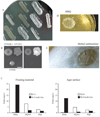Growth phenotypes of Pseudomonas aeruginosa lasR mutants adapted to the airways of cystic fibrosis patients
- PMID: 17493132
- PMCID: PMC2742308
- DOI: 10.1111/j.1365-2958.2007.05678.x
Growth phenotypes of Pseudomonas aeruginosa lasR mutants adapted to the airways of cystic fibrosis patients
Abstract
The opportunistic pathogen Pseudomonas aeruginosa undergoes genetic change during chronic airway infection of cystic fibrosis (CF) patients. One common change is a mutation inactivating lasR, which encodes a transcriptional regulator that responds to a homoserine lactone signal to activate expression of acute virulence factors. Colonies of lasR mutants visibly accumulated the iridescent intercellular signal 4-hydroxy-2-heptylquinoline. Using this colony phenotype, we identified P. aeruginosa lasR mutants that emerged in the airway of a CF patient early during chronic infection, and during growth in the laboratory on a rich medium. The lasR loss-of-function mutations in these strains conferred a growth advantage with particular carbon and nitrogen sources, including amino acids, in part due to increased expression of the catabolic pathway regulator CbrB. This growth phenotype could contribute to selection of lasR mutants both on rich medium and within the CF airway, supporting a key role for bacterial metabolic adaptation during chronic infection. Inactivation of lasR also resulted in increased beta-lactamase activity that increased tolerance to ceftazidime, a widely used beta-lactam antibiotic. Loss of LasR function may represent a marker of an early stage in chronic infection of the CF airway with clinical implications for antibiotic resistance and disease progression.
Figures






References
-
- Allesen-Holm M, Barken KB, Yang L, Klausen M, Webb JS, Kjelleberg S, et al. A characterization of DNA release in Pseudomonas aeruginosa cultures and biofilms. Mol Microbiol. 2006;59:1114–1128. - PubMed
-
- Barth AL, Pitt TL. The high amino-acid content of sputum from cystic fibrosis patients promotes growth of auxotrophic Pseudomonas aeruginosa. J Med Microbiol. 1996;45:110–119. - PubMed
Publication types
MeSH terms
Substances
Grants and funding
LinkOut - more resources
Full Text Sources
Other Literature Sources
Medical
Molecular Biology Databases

